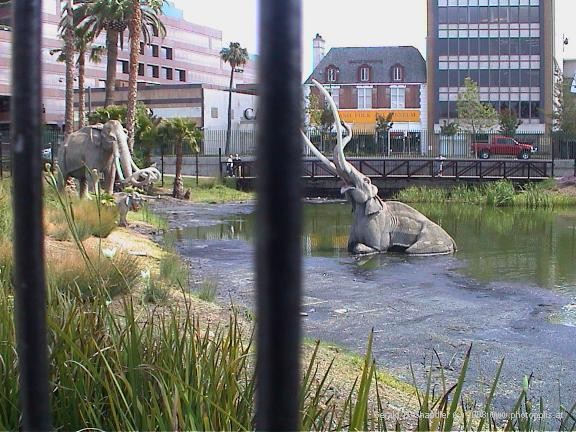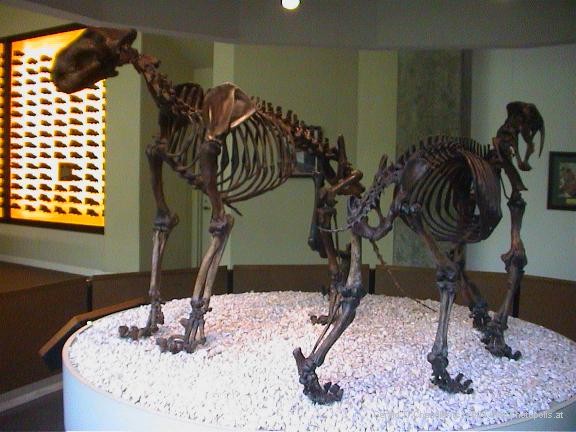Home | Front Page | Index | Blog | New | Contact | Site Map
California | Photos | Map
Los Angeles:
Doings | Eatin' | Bldgs | More | Hancock Park
Caltech:
Campus | Reunion | Lloyd House | JPL
Yosemite Valley
Yosemite Falls
Nevada Fall

Britain 2002
USA 2001
USA 2002
USA 2003
Virginia
North Carolina
South Carolina
Georgia
Florida
Alabama
Louisiana
Texas
Arizona
California
Nevada
Index 1999-2002
Index 2002-2003

Mannequin mastodons in Hancock Park with Wilshire Blvd buildings |
Long before Gerry lived in Los Angeles, long before his parents and grand parents came to Los Angeles, and even long before the Spanish and native indians came to Los Angeles, there were ancient animals, many now extinct, living in the area. After the last ice age, some 20,000 years ago, what are now called the La Brea Tar pits formed. It was a deathly trap for visitors: Under a shallow water hole was a soft layer of soft asphalt or tar. Any animal who came to drink and walked too far into the water was in danger of never coming out. And such was the fate of many. Over the last hundred years literally thousands and thousands of bones of prehistoric mastodons, wolves, vultures, and many tiny creatures have been pulled out of the pits.
About one hundred years ago a Mr Hancock bought a ranch on what was then very rural Wilshire Blvd. Through good investments, good management, and good luck, he formed the Hancock Oil Company that extracted oil from formations similar to those of the tar pits and became very rich. On the property of his ranch was located those very tar pits. After the discovery of the fossil riches located in them, and after he was rich and had moved, the site became Hancock Park.
Hancock Park is bordered by Wilshire Blvd and lies about 6 miles west of Downtown and 4 east of Beverly Hills. Whereas 100 years ago the area was either unused or ranched, and 75 years ago was farmed, today it is high-priced real estate with art museums and expensive apartments as neighbors. About 25 years ago another rich man made a major contribution and the Page Museum was built and named after him. (There is a small connection to Caltech here: Mr Page also contributed the funds for Page House, a dormitory at Caltech.)

Page Museum - Ancient horse petrified skeletons |
We'd been to the La Brea Tarpits several times together (and Gerry made one of his first solo trips from home to them at the age of 15) but before this trip we'd never been inside the Page Museum. It doesn't rank with the great museums, like the New York or Smithsonian (DC) museums of Natural History but it does have some nice exhibits, all of them "originals" including many skeltons of ancient horses and wolves. We were quiet happy to go over again some of the discoveries made and marvel at what evolution does.

Page Museum map of old Spanish and Mexican ranchos |
One nice little surprise in the Page Museum was a map showing the borders of the original Spanish and Mexican ranchos or land grants. Europeans came to California as settlers in about 1760 when Spanish authorities founded a string of missions in California. The earliest of them in the Los Angeles area was Mission San Gabriel. El Pueblo de Los Angeles was founded as a suburb. In an anti-clerical move, eventually the missions were shut and their lands transferred to non-clerical owners. Thus the orgin of land grants.
Before coming Gerry got the idea of tracing the history of the house in which he grew up. Long before he was born it was part of a land grant and then became farms (just like Rancho La Brea developed.) When he was a child, neighbors still raised cows, chickens, and turkeys. We spent a few hours in the Los Angeles main library searching for records. That was just enough time to learn some basic history and get an idea of where the sources might be. Finding this map, thus, was a bonus.